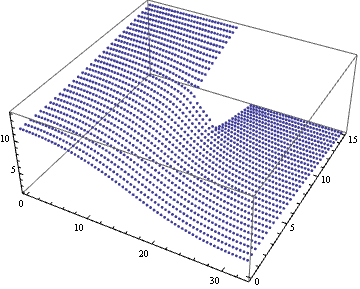Here's my FDM-based solution for your problem:
{{xl, xr}, {yl, yr}} = {{0, 33}, {0, 15}};
sf = 2;
nx = sf xr; ny = sf yr;
dx = (xr - xl)/nx; dy = (yr - yl)/ny;
xmidl = 15; xmidr = 18; ymid = 9;
h1 = 14; h2 = 2;
formula = Select[
Flatten@Table[
h[x - dx, y] + h[x + dx, y] + h[x, y - dy] + h[x, y + dy] - 4 h[x, y] == 0, {x, xl,
xr, dx}, {y, yl, yr, dy}][[2 ;; -2, 2 ;; -2]],
FreeQ[#, h[x_, y_] /; xmidl < x < xmidr && y > ymid] &];
oneSideD1[most__, "left"] := oneSideD1[most, -1]
oneSideD1[most__, "right"] := oneSideD1[most, 1]
oneSideD1[h_, x_, step_, direction : 1 | -1] :=
direction ((3 h@x)/(2 step) - (2 h[x - direction step])/step + h[x - 2 direction step]/
(2 step))
bcxl = Table[oneSideD1[h[#, y] &, xl, dx, "left"] == 0, {y, yl, yr, dy}][[2 ;; -2]];
bcxr = Table[oneSideD1[h[#, y] &, xr, dx, "right"] == 0, {y, yl, yr, dy}][[2 ;; -2]];
bcyl = Table[oneSideD1[h[x, #] &, yl, dy, "left"] == 0, {x, xl, xr, dx}];
bcyr@1 = Table[h[x, yr] == h1, {x, xl, xmidl, dx}];
bcyr@5 = Table[h[x, yr] == h2, {x, xmidr, xr, dx}];
bcyr@3 = Table[
oneSideD1[h[x, #] &, ymid, dy, "right"] == 0, {x, xmidl, xmidr, dx}][[2 ;; -2]];
bcyr@2 = Table[
oneSideD1[h[#, y] &, xmidl, dx, "right"] == 0, {y, ymid, yr, dy}][[2 ;; -2]];
bcyr@4 = Table[
oneSideD1[h[#, y] &, xmidr, dx, "left"] == 0, {y, ymid, yr, dy}][[2 ;; -2]];
set = Flatten@{formula, bcxl, bcxr, bcyl, bcyr /@ Range@5};
var = Union@Cases[set, h[a_, b_], ∞];
{b, mat} = CoefficientArrays[set, var];
sol = LinearSolve[mat, -N@b];
coord = List @@@ var;
ListPointPlot3D[Flatten /@ ({coord, sol}\[Transpose]), PlotRange -> All]

Remark
I've used one-sided difference formula i.e. oneSideD1 to discretize the Neumann boundary condtions. For your simple Neumann b.c., it's not a bad idea to handle them with reflection of course, but do notice reflection is hard to extend to more general cases. (If you want to learn more about one-sided formula, start from page 6 of this book. )
sf should be an Integer.
You can also use
SetAttributes[h, NHoldAll]
sol2 = Solve[N@set, var]; // AbsoluteTiming
to solve the equation set, but this approach is slower. (The speed difference isn't obvious in this simple case though.)




selectedeq = Select[eq, Count[#, Alternatives @@ inner, Infinity] < 2 &];line in this answer with the help of document, then you'll have an idea about what to do. $\endgroup$